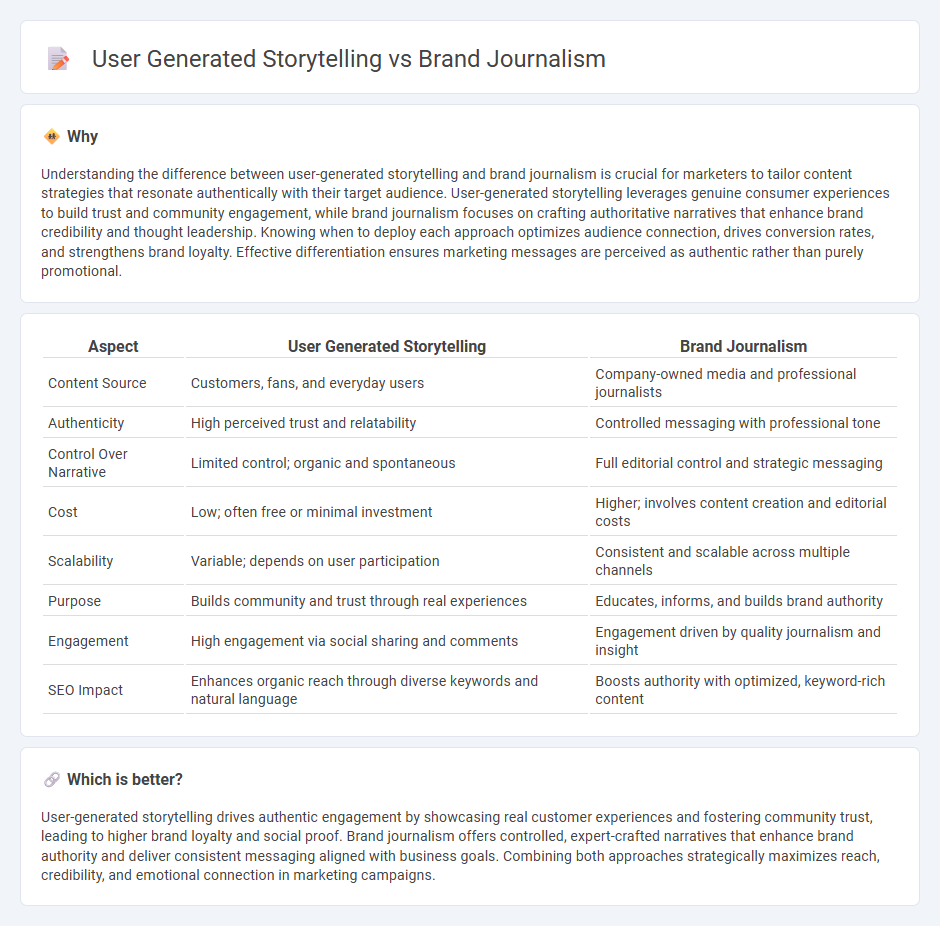
User-generated storytelling leverages authentic consumer experiences to build trust and foster community engagement, while brand journalism focuses on creating authoritative content that highlights company values and expertise. Both strategies maximize audience connection by blending genuine voices with professional storytelling techniques. Explore how integrating these approaches can elevate your marketing impact.
Why it is important
Understanding the difference between user-generated storytelling and brand journalism is crucial for marketers to tailor content strategies that resonate authentically with their target audience. User-generated storytelling leverages genuine consumer experiences to build trust and community engagement, while brand journalism focuses on crafting authoritative narratives that enhance brand credibility and thought leadership. Knowing when to deploy each approach optimizes audience connection, drives conversion rates, and strengthens brand loyalty. Effective differentiation ensures marketing messages are perceived as authentic rather than purely promotional.
Comparison Table
| Aspect | User Generated Storytelling | Brand Journalism |
|---|---|---|
| Content Source | Customers, fans, and everyday users | Company-owned media and professional journalists |
| Authenticity | High perceived trust and relatability | Controlled messaging with professional tone |
| Control Over Narrative | Limited control; organic and spontaneous | Full editorial control and strategic messaging |
| Cost | Low; often free or minimal investment | Higher; involves content creation and editorial costs |
| Scalability | Variable; depends on user participation | Consistent and scalable across multiple channels |
| Purpose | Builds community and trust through real experiences | Educates, informs, and builds brand authority |
| Engagement | High engagement via social sharing and comments | Engagement driven by quality journalism and insight |
| SEO Impact | Enhances organic reach through diverse keywords and natural language | Boosts authority with optimized, keyword-rich content |
Which is better?
User-generated storytelling drives authentic engagement by showcasing real customer experiences and fostering community trust, leading to higher brand loyalty and social proof. Brand journalism offers controlled, expert-crafted narratives that enhance brand authority and deliver consistent messaging aligned with business goals. Combining both approaches strategically maximizes reach, credibility, and emotional connection in marketing campaigns.
Connection
User-generated storytelling and brand journalism intersect by amplifying authentic consumer voices that enrich brand narratives, enhancing credibility and engagement. Brands leverage user-generated content in their journalistic efforts to create relatable stories that resonate deeply with target audiences. This synergy drives organic reach and fosters trust, essential components of effective marketing strategies.
Key Terms
Content Control
Brand journalism provides companies with full content control, ensuring consistent messaging and alignment with brand values across all platforms. User generated storytelling, however, involves relinquishing control to consumers who create authentic, diverse content that enhances trust and engagement. Discover how strategic content control impacts brand reputation and customer connection.
Authenticity
Brand journalism delivers curated content to shape a company's narrative, emphasizing control and consistency in messaging to build trust. User-generated storytelling leverages genuine customer experiences and personal voices, driving higher authenticity and emotional engagement. Explore how these storytelling approaches impact brand credibility and consumer loyalty.
Source Credibility
Brand journalism leverages authoritative sources such as company experts and official data to establish a reliable narrative that enhances source credibility. User-generated storytelling, while often perceived as more authentic, varies in trustworthiness depending on the individual contributor's reputation and transparency. Explore how source credibility shapes consumer trust in marketing strategies to understand their impact fully.
Source and External Links
The Resurgence of Brand Journalism and Why It's Here to Stay - Brand journalism is the use of honest journalism techniques combined with storytelling to communicate brand-informed stories subtly associated with a brand, focusing on truthful, customer-centric content rather than direct advertising.
What Is Brand Journalism -- and Why It Matters | NYTLicensing - Brand journalism uses journalistic best practices to create authentic storytelling that connects consumers with the brand by building credibility and trust, emphasizing brand identity and thought leadership rather than direct sales.
What Are the 5 Elements of Brand Journalism?- Managing Editor - Brand journalism tells stories connected with a brand's values and activities without focusing on product selling, aiming to build trust through authenticity and position the brand as a reliable expert using diverse content forms like articles, videos, and podcasts.
 dowidth.com
dowidth.com